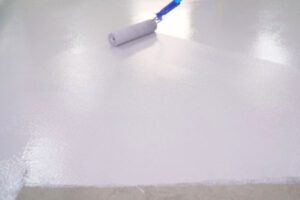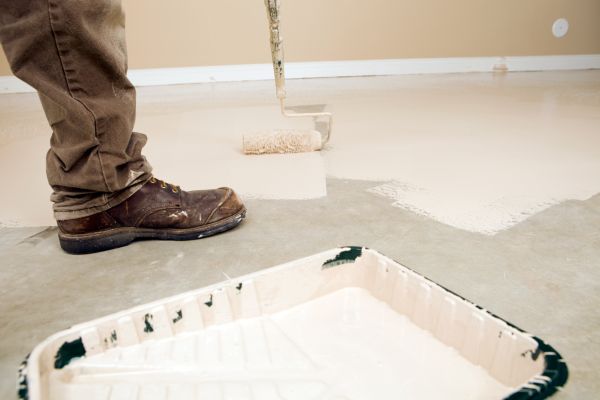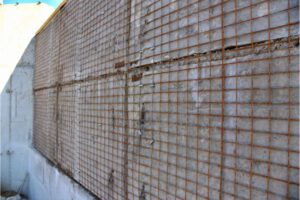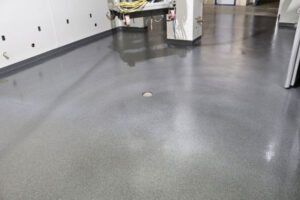Renowned for its rugged durability and versatile aesthetic, concrete surfaces grace countless homes and commercial spaces with their resolute charm.
Yet, there comes a time when one may seek to refresh or revitalize these surfaces, prompting the question: Can you paint over concrete sealer?
The answer lies in understanding the relationship between sealed concrete and the many of paint products designed to work with it.

As you prepare to transform your space, knowing the ins and outs of painting over sealed concrete is imperative.
Keep reading to unveil the secrets of selecting the ideal paint to seal concrete, ensuring your project’s success and the long-term beauty of your concrete surfaces.
Introduction to Concrete Sealers
Protecting concrete surfaces necessitates the use of specialized products, as concrete, while durable, is susceptible to a variety of factors that can compromise its integrity and appearance. Among these protective measures, concrete sealers stand out for their ability to create a barrier against moisture, stains, and environmental elements. The correct application of a sealer can prolong the life span and enhance the aesthetic value of concrete installations.

When dealing with sealed surfaces, one common question arises: can you paint over concrete sealer? It’s a pertinent question that addresses the concern of homeowners and concrete professionals looking to refresh or update their concrete. The answer is not straightforward, as it depends on the type of sealer used and the specific requirements of the paint intended to be applied over it.
For those seeking to revamp sealed concrete, it’s crucial to select the right type of paint to seal concrete, ensuring that the chosen product is compatible with the existing sealer. If compatibility is assured, the renewal process can lead to a rejuvenated finish that combines the robust protection of the sealer with the fresh, new look of paint. Yet, the approach and materials used must be carefully considered to avoid poor adhesion or damage to the sealed surface.
Types of Concrete Sealers
When exploring the nuances of protecting concrete, one encounters two primary categories of sealers: topical and penetrating. Topical sealers form a protective layer on the concrete surface, offering a glossy or matte finish that guards against spills and wear. Conversely, penetrating sealers seep into the concrete to provide protection from within, preserving the natural appearance of the concrete while fending off moisture and contaminants.
Selecting the correct type of sealer is contingent upon the exposure conditions and traffic patterns the concrete will endure. Indoor environments with minimal exposure to harsh conditions are well-suited to lighter-duty sealants, while spaces subjected to heavy foot traffic or extreme weather conditions may require a robust, penetrating sealer for optimal longevity and resilience

A professional assessment of the concrete’s state, including any previous sealing work, determines the compatibility of a new sealer application. Undertaking this evaluation ensures that the renewal process incorporates the most effective products, like concrete paint and sealer in one, merging aesthetic enhancement with reliable protection in a single application.
Reasons for Wanting to Paint Over Concrete Sealer
Homeowners opt to apply fresh paint over sealed concrete to introduce new colors or to refresh the existing hue, brimming life into a once lackluster surface. It’s not merely an aesthetic choice but one that may reflect changes in decor trends or personal preference for space reinvigoration.

Painting over sealed concrete can also be a response to the wear and tear of daily use, repairing the scratches, dings, and fading that occur over time. This upkeep is not just cosmetic; it serves as an additional layer of defense against future damage, seamlessly blending protection with revitalization.
Companies specializing in commercial and industrial spaces may seek to brand their floors with company colors or safety markings. This necessitates a seamless application over previously sealed floors, leveraging the durability of the sealant with the specificity of paint designed for high-traffic areas.
Assessing the Condition of the Sealed Surface
Before embarking on the task of repainting, a thorough inspection of the sealed concrete surface is imperative. It is essential to identify any cracks, peeling, or flaking on the sealer, as these will significantly impact the adhesion and finish of the new paint job. A surface free of such imperfections is conducive to successful repainting.
Experts also examine the type and quality of the existing sealant to ascertain the appropriate painting strategy. For a robust adhesion, the chosen paint should possess characteristics that allow it to bond well with the sealer currently in place. This compatibility is a cornerstone for the durability of the subsequent layers.
The assessment of cleanliness is a crucial step in preparing for repainting. Surfaces tainted with oil, grease, or dirt can hinder the paint’s ability to form a lasting bond with the sealer. Professionals employ meticulous cleaning methods to ensure the surface is immaculate before applying new paint.
Choosing the Right Type of Paint
Selecting the appropriate paint to apply over sealed concrete requires attention to the specific properties of both the sealant and the new paint. A high-quality paint to seal concrete must not only adhere well but also maintain its appearance and function over time. Contractors often recommend products specially formulated to work with sealed surfaces, ensuring the paint bonds effectively without compromising the sealer underneath.
For optimal results, professionals might opt for a concrete paint and sealer in one. This combination product simplifies the process by fusing the protective qualities of a sealer with the aesthetic appeal of paint, cutting down on the steps needed for application. Its specialized composition guarantees compatibility and offers a streamlined solution for both protecting and beautifying concrete surfaces.

When a painted finish is required on floors or outdoor spaces, a painted concrete sealer serves a dual purpose. Not only does it protect the painted surface from abrasion and environmental factors, but it also seals the underlying concrete, providing an extra layer of defense against moisture and wear. Careful selection and application of this product type are fundamental for a lasting and resilient finish, maintaining the surface’s visual and structural integrity.
Surface Preparation for Painting
Revitalizing a sealed concrete surface with a fresh coat of paint entails meticulous preparation to ensure the success and longevity of the new finish.
It begins with testing adhesion compatibility, a critical step to determine if the paint will properly bind to the existing sealer.
From there, attention shifts to the repair and patching of any decrepit areas, creating a homogenous base that will support the new coloring uniformly.
Priming plays an essential role, serving as an intermediary layer that promotes adhesion and color consistency.
The act of applying paint to sealed concrete is where transformation unfolds, but the drying and curing process that follows is equally critical, affecting the endurance and the protective qualities of the finished surface.
Lastly, focusing on maintenance and longevity ensures that the efforts invested in preparation and painting yield a lasting benefit, preserving the concrete’s renewed appearance and fortification against wear and environmental assaults.
A. Testing Adhesion Compatibility
Before repainting, a crucial process is to evaluate whether the new paint will adhere properly to the sealed concrete. Professionals conduct adhesion tests by applying a small section of paint to the sealed surface and monitoring its bonding behavior. This proactive step is vital to prevent future flaking or peeling, ensuring a stable and attractive finish.
B. Repairing and Patching Sealed Concrete
During surface preparation, attention to the condition of sealed concrete is paramount, necessitating repairs and patching as an integral step prior to repainting. Cracks, holes, or uneven sections on the concrete surface demand a careful application of filler or patching compounds specifically designed to work well with sealants. Professionals ensure a smooth and level surface is achieved, setting the stage for a uniform and flawless paint application.
C. Priming the Sealed Surface
Prior to introducing a new layer of paint, the priming stage is essential for bridging the sealant with the topcoat. A thorough application of primer enhances the paint’s grip and ensures a consistent color across the expanse of the concrete. By selecting a primer that’s compatible with both the sealer and the intended paint, professionals create a receptive base, which is vital for a smooth transition and long-term adhesion of the new paint layer.
D. Applying Paint to Sealed Concrete
The journey to revitalizing a concrete surface reaches a pivotal phase with the application of paint over the sealed area. Professionals deftly apply the chosen formulation, ensuring even distribution and adherence to achieve a surface that’s not only visually appealing but also resilient. The precision in this step cannot be overstated, with careful attention to cover every inch uniformly to prevent future issues related to coverage or protection.
E. Drying and Curing Process
Once the paint is applied to the sealed concrete, a crucial phase begins: the drying and curing process, which is not to be rushed. During this stage, the newly applied substances must be left undisturbed to properly bond, a period that typically varies from a few hours to several days, depending on the product specifications. The environmental conditions, such as
humidity and temperature, play a pivotal role in this process, influencing the rate at which the paint sets and ultimately the durability of the finish.
F. Maintenance and Longevity
To preserve the integrity and appearance of freshly painted concrete surfaces, ongoing maintenance is vital. Regular cleaning regimes, coupled with periodic resealing, can protect the new coat from deterioration due to traffic and environmental conditions, thereby ensuring the sealant and paint perform optimally over an extended period.
Conclusion
In conclusion, utilizing concrete sealers is essential in safeguarding the structural stability and aesthetic quality of concrete surfaces.
The ability to paint over a concrete sealer adds versatility, allowing for updates and enhancement of the surface.

However, success hinges on choosing the right type of paint that aligns with the sealer and ensuring meticulous preparation of the sealed concrete.
Through proper assessment, repair, priming, and careful application, one can achieve a lasting and harmonious finish.
Regular maintenance post-application further ensures the painted surface’s longevity, maintaining its defense against daily wear and environmental stressors.
Therefore, concrete sealers not only provide robust protection but also offer the flexibility to refresh and customize concrete surfaces to meet evolving design preferences and functional demands.






